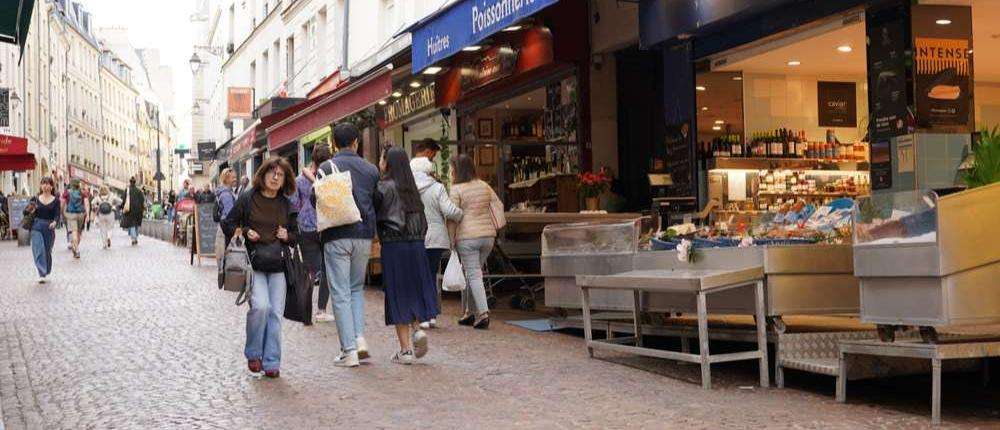Stroll along the famous rue Mouffetard
Posted in Hotel le 15 December 2023

Located in the 5th arrondissement of Paris, a stone's throw from the Hôtel de l'Espérance, rue Mouffetard is one of the oldest streets in Paris. Let's explore this street in the Latin Quarter which attracts Parisians and tourists with its dynamism and friendliness.
The origins of rue Mouffetard
At its origins, in the Neolithic era, the famous rue du Quartier Latin was nothing more than a simple ford which led to the Seine. In the 1st century AD, the Romans developed the road to facilitate travel to Rome, and in particular the Paris-Lyon route. From then on, rue Mouffetard is and will remain a very busy road, with heavy traffic of travelers and merchants.
Until 1912, the Roman road was crossed by the Bièvre , a tributary of the Seine which is now underground. At each end of the street, we find the Saint-Médard church, built in the 17th century, and the Place de la Contrescarpe, open to the public in the 20th century.
What does “Mouffetard” mean?
The meaning of the name of rue Mouffetard is divided, but most historians think it is a reference to the pestilential odor of the street during the Middle Ages. Indeed, the word "Mouffetard" comes from the name "mofette" or "moufette", which evokes an unbearable nauseating odor. However, the Roman road was, at the time, crossed by the Bièvre, which served as a natural waste disposal site for all the papermakers, skinners, trippers and dyers in the area. Waste was poured there without any restraint, which produced a foul smell throughout the street.
For others, the name of the street would rather come from " mont Cetardus ", a small hill on the right bank of the Bièvre. Throughout the Middle Ages, from the Sainte-Geneviève mountain to the banks of the Seine, houses were built all along the route and on a small hill sheltered from the floods of the Seine: Mount Cetardus. Over time, the axis will take the name of Mont-Cétard, then Mont-Fétard, before becoming "Mouffetard".
A dynamic street at the gates of Paris
Until the 18th century, rue Mouffetard remained at the gates of Paris. It will not be attached to the capital until 1724 . Until now, Paris has been surrounded by an immense wall, established by Philippe Auguste in the 13th century. Near rue Mouffetard, this wall passes right next to Place de la Contrescarpe.
Until the 15th century, the Mouffetard district retained a very rural atmosphere , with fields and numerous vineyards. There is simply a small village around the Saint-Médard church and the Saint-Marcel church (now disappeared).
The urbanization of rue Mouffetard began with the increasing number of travelers and merchants wishing to reach Paris via Porte Bordelle . At the time, to bring food into the capital, traders had to pay a tax. To avoid this, they therefore settled at the gates of Paris, and in particular near the Place de la Contrescarpe .
Many taverns then sprung up, attracting people and offering a festive atmosphere. The best known is probably the Pine Cone , which has disappeared today, which received great names during the 19th century. But long before, great people met there: Ronsard, Molière, Racine, du Bellay...
The famous treasure of rue Mouffetard
Most of the houses on rue Mouffetard date from the 16th and 17th centuries. Work is therefore regularly undertaken to rejuvenate the buildings. This is how in 1938, the building at number 53 on the street was destroyed. Among the debris, a worker discovers rolls of canvas containing thousands of gold coins. In total, more than 3,300 gold coins dating from the time of Louis XV were found.
It seems that this treasure was hidden here by Louis Nivelle, the King's secretary, to ensure the future of his daughter.
Finally, the pieces were shared between the City of Paris, the 82 descendants of Louis Nivelle and the workers, after the Second World War. However , most of the treasure on rue Mouffetard was sold at auction.
The essential addresses of rue Mouffetard
From the Place de la Contrescarpe to the Saint-Médard church, let's discover the addresses which have marked, and which still mark the history of the 5th arrondissement of Paris and this dynamic, gently sloping street.
- Number 1 previously hosted the famous La Pomme de Pin cabaret ;
- Number 6 housed a former 18th century butcher's shop, Aux deux oxen ;
- Number 14 was known, until 2018, for its confectionery, chocolate and coffee shop, “ Au Nègre Joyeux ” (its old listed one is now kept at the Carnavalet museum);
- Number 23 housed the famous Chiffonniers cabaret ;
- At number 52, we find a path paved with tombstones from the ancient necropolis of Saint-Médard;
- Number 53 hid the famous treasure of rue Mouffetard , with its 3,300 gold coins;
- Number 60 hosted the Iron Pot fountain . This historic monument from 1671 was an element of the drinking water distribution network, a building required by Marie de Medici;
- At number 61 was the Monge Barracks of the Garde République, itself installed on the former convent of the Mercy of Jesus. During the French Revolution, the monastery was nationalized, partially destroyed, then transformed into the Mouffetard barracks, before becoming the Monge barracks in 1861;
- Number 69 consecutively housed an old house, the Hôtel de Mainville, the revolutionary club Le Vieux Chêne , then a popular ball;
- Number 103 bears a commemorative plaque recalling the ordeal of the Parisians during the Siege of Paris, during the Franco-Prussian War (end of the 19th century);
- Number 120 houses the café restaurant Le Mouffetard , with a wooden front carved with Bacchus heads and bunches of grapes;
- Number 122 bears an old sign referring to an 18th century wine merchant, La Bonne Source ;
- At number 134, we find the sgraffito decor of an old 20th century butcher's shop , made by an Italian mason;
- Number 140 hid, under its attic, the entire editorial team of the newspaper " Les Temps Nouveaux ", an anarchist newspaper from 1895, created by Jean Grave.
Rue Mouffetard today
Nicknamed La Mouffe by regulars, Rue Mouffetard has changed a lot, but we still find the picturesque atmosphere of this historic district. If the road is lined with numerous houses from the 16th to the 19th century, the numerous local shops also contribute to this friendly and warm atmosphere. Artisans, small food shops and the permanent market add to the charm of this street, which is one of the busiest streets in Paris.
Today, walkers like to find bakers, wine merchants, market gardeners and grocers there, but they also like to take the time to sip a drink or have a bite to eat on the terrace of a bar, restaurant or point of sale. fast food.
A picturesque street in the 5th arrondissement, Rue Mouffetard is steeped in history and still bears the marks of a heavy, more or less festive past. From the Hôtel de l'Espérance , discover this essential street in Paris and enjoy a unique experience of the French art of living.
